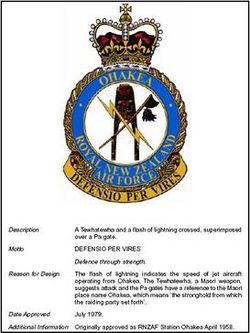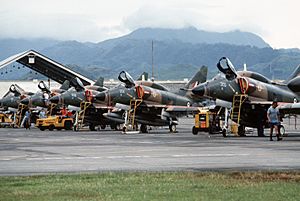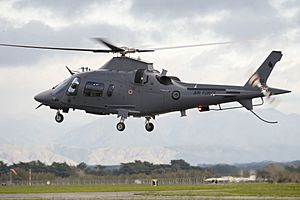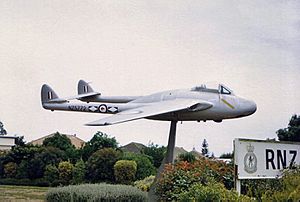RNZAF Base Ohakea facts for kids
Quick facts for kids
RNZAF Base Ohakea
Defensio Per Vires
Defence Through Strength
|
|||||||||||||||||||
|---|---|---|---|---|---|---|---|---|---|---|---|---|---|---|---|---|---|---|---|
 |
|||||||||||||||||||
| Summary | |||||||||||||||||||
| Airport type | Military | ||||||||||||||||||
| Owner | New Zealand Defence Force | ||||||||||||||||||
| Operator | |||||||||||||||||||
| Location | Bulls, New Zealand | ||||||||||||||||||
| Occupants |
|
||||||||||||||||||
| Elevation AMSL | 164 ft / 50 m | ||||||||||||||||||
| Coordinates | 40°12′22″S 175°23′16″E / 40.20611°S 175.38778°E | ||||||||||||||||||
| Runway | |||||||||||||||||||
|
|||||||||||||||||||
RNZAF Base Ohakea is a busy air force base in New Zealand. It's home to the Royal New Zealand Air Force (RNZAF). This base opened in 1939. You can find it near Bulls, about 25 kilometers northwest of Palmerston North. Ohakea also helps civilian planes if they need to land somewhere else. The base has a cool motto: Defensio per vires. This is Latin for "Defence through strength."
Contents
Ohakea's Early Plans: Airships!
Ohakea was first thought of as an air base way back in 1927. People considered it a great spot for a mooring mast. This mast would be for giant airships from the British Imperial Airship service.
The idea was to build one mast for a test flight. Then, they could expand it into a huge airship base. This bigger base would have three masts, special sheds for airships, and even make hydrogen gas.
However, Australia needed to agree to build masts too. If Australia didn't build them, there was no point for New Zealand. When Australia said no, New Zealand also decided not to go ahead with the airship base.
Ohakea's Military History
World War II Training Hub
During World War II, Ohakea was a very important training base for the RNZAF. Pilots learned to fly fighter planes here. Observers and navigators trained for medium bombers. Air gunners also got their training at Ohakea.
After the war, several squadrons were reformed at Ohakea. These included No. 14 Squadron RNZAF, No. 42 Squadron RNZAF, and No. 75 Squadron RNZAF. A repair depot also moved to Ohakea from Te Rapa.
In 1966, the Pilot Training Squadron (PTS) was renamed. It used to be called No. 1 Flying Training School.
Post-War Changes and Growth
After World War II, Ohakea became the RNZAF's main base for strike aircraft. Squadrons 14 and 75 were based here for a long time. No. 42 Squadron moved away in 1984. This allowed 2 Squadron RNZAF to move to Australia in 1991.
In 1993, all RNZAF pilot training moved to Ohakea. This training used to happen at Wigram Aerodrome. Also in 1993, a new part of the Air Force Museum of New Zealand opened at Ohakea.
Squadrons 14 and 75 were disbanded in 2001. No. 42 Squadron moved back to Ohakea in 2002. Today, about 1200 people work at Ohakea. This makes it the second-largest Air Force base in New Zealand.
Modern Upgrades and Future Plans
In 2009, there was a plan to put all RNZAF operations at Ohakea. However, the government changed its mind. They decided to keep two main air bases: Ohakea and Whenuapai.
In 2012, new helicopters arrived. These were the NH-90 and A-109 models. A new hangar was built to house these helicopters for No. 3 Squadron RNZAF.
Other important buildings were also added. A new main gate duty center was built for the RNZAF Police and Security Forces. An international air movements terminal was finished in 2014. This terminal is named after Sir Richard Bolt. It means Ohakea can now handle international civilian flights if Wellington Airport is closed.
No. 14 Squadron RNZAF was reformed in 2015. It now trains new pilots using the T-6C Texan II aircraft. This led to the Pilot Training Squadron being disbanded.
In 2017, the Republic of Singapore Air Force brought its F-16D fighter jets to Ohakea. They wanted to see if they could set up a training base there for their F-15 fighters. Flying in New Zealand offered more open airspace and mountains. However, the plan was cancelled because it was too expensive.
In 2019, construction began on new hangars and taxiways. These are for the P-8 Poseidon aircraft. These planes are expected to arrive in 2022. This means No. 5 Squadron RNZAF will move all its staff and new aircraft to Ohakea from Whenuapai by 2021.
Who Works at Ohakea?
About 1200 people work at RNZAF Base Ohakea.
Flying Squadrons
| Squadron | Aircraft | What They Do |
|---|---|---|
| No. 3 Squadron | NH90, AW109 LUH | Search and rescue, lifting heavy things, supporting troops, and helicopter training. |
| No. 14 Squadron | Beechcraft T-6 Texan II | Basic pilot training, and they are the Black Falcons Display team. |
| No. 42 Squadron | Beechcraft Super King Air | Training pilots for twin-engine planes, and VIP transport. |
| Central Flying School | Beechcraft T-6 Texan II | Training pilots to become instructors. |
Other Important Units
- Flying Training Headquarters
- RNZAF Operations Squadron
- RNZAF Police
- RNZAF Security Forces
- RNZAF Logistics
- Base Medical Flight
- RNZAF Refuellers
- RNZAF Fire Rescue
Ohakea's Civilian Role
Ohakea is a backup airport for large civilian planes. This includes aircraft like the Boeing 787 and Boeing 777. If an airport like Auckland International Airport is closed, these planes can land at Ohakea.
Ohakea has the facilities to handle many passengers. A new terminal was completed in 2019.
On January 29, 2017, an Emirates Airbus A380 landed at Ohakea. It was diverted because another A380 was blocking the runway at Auckland Airport. The Emirates A380 was refueled by RNZAF trucks. Then it flew to Auckland. This was the first time an A380 had ever landed at Ohakea!
People have also studied if Ohakea could be used for both military and civilian cargo flights. This included making the main runway longer to fit planes like the Boeing 747.
Motor Racing at Ohakea
The Ohakea Airfield was also used as a temporary motor racing track. This happened mostly in the 1950s.
A 5.6-kilometer track hosted the first ever New Zealand Grand Prix in 1950. A shorter 3.5-kilometer track hosted the Ohakea Trophy from 1951 to 1956. Other national races were held there from 1959 to 1962. The track was even reopened for special historic racing events in the 1980s.
Images for kids





